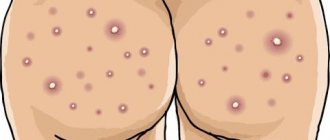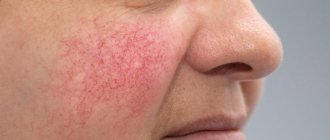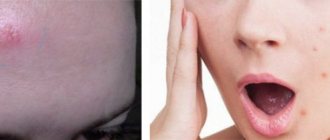In children after birth, rashes are often physiological; they should not cause much concern to parents. The skin adapts to its new habitat - without water, which is often accompanied by some problems. As a result, the influence of any negative factors can cause a skin rash.
The first children's medical center offers the services of qualified pediatric dermatologists in Saratov. The Center’s specialists aim not only to rid your child of the external symptoms of the disease, but also to find and eliminate the cause that caused it. This is very important, because if the cause of the disease is not eliminated, it can recur again and again, taking a chronic course.
Features of children's skin
At birth, babies have very thin skin. The skin of a newborn is almost half as thick as the skin of an adult. The outer layer thickens with age.
The skin of newborns is red or purple in color due to the close proximity to the upper layer of blood vessels and an insufficient layer of subcutaneous cellular tissue, as a result, the skin appears “transparent”. This phenomenon is especially pronounced if the baby is frozen - the appearance of a marbled vascular network on the body is observed.
Moisture evaporates faster from the skin of newborns. Children are more susceptible to bacteria, viruses, fungi and mechanical influences. Thickening of the skin begins at 2-3 years of age and ends by 7 years.
Pimples on the face, cheeks or butt in a 4, 5, 6 year old child: causes
Milia
Milia, or water pimples, are tiny white bumps that appear on the face, including the nose, cheeks, or chin, most commonly in children between the ages of 4 and 6. In some cases, milia may also appear on the upper body, as well as also on your baby's arms and legs.
The most distinct difference between baby acne and milia is the color of the bumps. Baby acne is characterized by small red bumps, milia is characterized by tiny white bumps.
Although this child's skin condition can develop at any age, it usually develops during the preschool years of 5 to 6 years. More than 50 percent of all children of different ages have experienced the development of milia in the short term.
Milia is also more common in children born and living in warm climates Milia and pimples on the face and butt are also associated with sweat caused by clothing or fever This skin condition develops in children because tiny pimples are formed as a result of the baby's skin's sebaceous glands not working properly .
Although you may be concerned about the sudden development of pimples or milia in your child, remember that such inflammations usually do not develop for long, being present on the skin for no more than a month and most often disappear within one week. In most cases, milia disappears within a few weeks without any - or treatment Sometimes milia infects a child during the first three months of life.
Ways to quickly get rid of pimples overnight!
Pyoderma in a child
If you take your baby's hygiene seriously, you can prevent many health problems. This also applies to skin pathologies - dermatitis, which has numerous varieties. The most common form of dermatitis in childhood (especially in the first months of life) is pyoderma.
Pyoderma is a purulent skin disease, which is a group of pathologies that develop against the background of penetration of pyogenic microorganisms into the skin. Parents should take into account the ways of transmission of pyoderma: germs are transmitted when the child comes into contact with sick people or a contaminated object.
The disease is most often diagnosed in childhood and has many types. There is an opinion that the cause of pyoderma lies in poor diet and poor hygiene. Although this is not entirely true. This skin pathology develops under the influence of various pathogens: streptococci, staphylococci, pneumococci, Pseudomonas aeruginosa, E. coli, etc.
Often the human body is the habitat of certain microorganisms, which are activated when protective functions are reduced, which leads to the appearance of their pathogenic qualities.
Since the protective function of newborns and infants is more weakened, pyoderma in such patients occurs in a severe form. This happens if treatment is not started in a timely manner and the baby is not properly cared for. In the body of children under 2 months of age, there is no independent production of antibodies. As a result, it is important to care for the baby’s skin throughout the body.
Why might a child develop a rash on his face?
There are a lot of diseases that are accompanied by a rash. In order to distinguish them, you need to take into account the nature of the rash: color, size, dynamics of manifestation. The accompanying symptoms cannot be ignored. All rashes can be classified into 2 groups:
- primary - affecting healthy skin;
- secondary - appear as the primary develops.
The table shows the most common primary rashes:
| Appearance of the rash | Cause | Associated symptoms |
| Small red pimples. The boundaries are unclear, the rash appears in the form of clusters that can merge into one spot. | Allergy | Itching, drowsiness, bad mood, slight fluctuations in body temperature. Sometimes - redness of the eyes, runny nose. |
| “Mosquito bites” are pinkish or red pimples. They have a pronounced center surrounded by a border. The boundaries are clear, the number is gradually increasing. | Infectious diseases (measles, rubella, scarlet fever, etc.) | Severe increase in body temperature, chills, itching. |
| Rashes in the form of blisters filled with cloudy or white liquid. | Herpes | Severe pain in the area of the rash, increased body temperature (from 37.3 to 38°C). ARVI symptoms are often associated. |
| Watery pimples with a blackhead in the center. At first they appear in the form of compactions, but gradually become softer. | Molluscum contagiosum (we recommend reading: what molluscum contagiosum looks like in children: photo) | None. Rarely - itching. |
| Pink spots with purulent accumulations in the center. | Streptoderma (more in the article: effective treatment of streptoderma in a child) | Febrile fever, general intoxication of the body, enlarged lymph nodes. |
| White pimples on the mucous membrane of the mouth or around the lips (we recommend reading: why do rashes appear around a child’s mouth?). Accompanied by a cheesy coating. | Candidiasis | Burning in the affected areas, loss of appetite. |
| Small red pimples that appear after overheating. | Prickly heat | None. |
READ ALSO: Rash on the thighs: photos, possible diseases, treatment | Skin diseases
Treatment and prevention
Prevention and treatment of rashes in a child begins with eliminating the factors that provoke this condition. If the exact cause cannot be established, all known preventive and therapeutic measures must be taken:
- correction of nutrition for a nursing mother;
- for children over 2 years old - strict control over the diet;
- the frequency of hygiene procedures is increasing, they are performed according to all the rules with the obligatory use of creams, oils and powders;
- acne will go away faster if you add a decoction of chamomile, string or celandine to the water when bathing and washing;
- medicinal ointments (Bepanten, Desitin) and soft baby creams are used only as prescribed by a doctor.
News MirTesen
Acne vulgaris in adolescents
What are acne vulgaris?
Acne vulgaris (acne) is a disease that can affect approximately 80% of young people from 14 to 30 years old. It manifests itself as inflamed nodules that can “pop up” on the skin of the face, chest, neck and back. The disease is very common; however, only 20% of patients consult a doctor; For the rest, acne vulgaris occurs in a mild form and is often considered a physiological condition. The peak of the disease falls at puberty - 14-16 years, in girls slightly earlier than in boys, which is explained by the earlier onset of puberty); rashes continue, as a rule, until 20-25 years.
How are they formed?
During puberty, our body begins to produce a huge amount of sex hormones. These hormones increase the activity of the sebaceous glands, which have the ability to clog pores, resulting in comedones (plugs). Due to the presence of comedones, sebum simply does not have the opportunity to be released onto the surface of the skin; sebum production continues at the same time. As a result of these processes, bacteria that are very viable begin to develop in the clogged follicle. They provoke the process of inflammation, and it happens that the follicle ruptures. Leukocytes begin to fight inflammation, which simultaneously destroy bacteria and die themselves. The result is the appearance of pus.
The main reasons for the development of rashes.
- Poor nutrition (spicy, salty, a lot of sweets, alcohol), dry eating increases the activity of the sebaceous glands.
- Stress can increase the severity of the condition and cause new acne. In turn, acne itself causes stress, and squeezing it out worsens a person’s appearance. Surveys of a large number of patients suffering from acne have shown that many of them experience feelings of shame, embarrassment and anxiety, and lack of self-confidence. Severe acne can cause anger and anxiety.
- Premenstrual exacerbations. About 70% of girls note an exacerbation of inflammatory phenomena 2-7 days before menstruation. It is possible that this is due to changes in the hydration of the follicular epithelium in the premenstrual period.
- Hormonal changes, diseases associated with the endocrine system, as well as changes associated with age can cause acne.
- Sweating. 15% of patients noted the negative impact of humidity on the course of the disease, especially in cases where a person lives in a humid, warm environment;
- Ultraviolet irradiation. Many patients and doctors are convinced that sunlight has a positive effect on acne. There is no scientific evidence for this. It is possible that the improvement is due to the psychological effects of tanning.
- Hereditary predisposition is of undoubted importance in the occurrence of acne vulgaris, the severity of its course, localization, prevalence and sensitivity to therapy. According to dermatologists, in 45% of schoolchildren with acne vulgaris, one or both parents also noted acne, while at the same time, acne vulgaris was observed only in 8% of schoolchildren whose parents did not have acne. A hereditary predisposition to the appearance of acne vulgaris has also been confirmed by genetic studies on twins.
- Smoking has a negative effect on the progression of acne.
What types of acne are there?
Acne comes in different forms and manifests itself in different ways:
- In the form of black dots - hard horny scales that impede the access of sebum. The outer part of the cork fills with dust and becomes brown or dark. Acne usually appears on the nose, forehead and chin, as well as on the back and chest.
- Whiteheads (millet acne) are pinpoint nodules comparable in size to grains, occurring due to stretching of the gland and sebum retention. They are usually located on the cheekbones and eyelid area. Such acne occurs one at a time or in groups.
- Acne vulgaris (ordinary) appears as a result of constant inflammation of the sebaceous glands. They usually form in adolescents during puberty. The condition of the skin worsens due to poor hygiene and abuse of unhealthy foods.
- Pustular acne with a purulent cap is usually red in color and appears as a result of damage to the epidermis and the release of harmful organisms to the outside. The main reason for the formation of pustules is squeezing out acne.
- Phlegmonous acne is a tumor. They are formed as a result of damage to a large number of sebaceous glands. Phlegmonous acne grows together and turns into abscesses or ulcers. At the site of their opening, scars form.
- Conglobate acne is round in shape and is connected by a staphylococcal bacillus. This is the most dangerous acne, affecting the side of the cheeks, back, and neck. This disease stimulates the formation of nodes, which consist of individual bulges. After healing, a scar remains in their place.
What are some tips for preventing acne vulgaris?
- Advice one. You can't sunbathe. We often hear that in the sun, acne on the chin and body disappears on its own. Sometimes this really happens, but everything is not as simple as it seems. Sun exposure causes increased sebum production, which is undesirable.
- Tip two. You can't wash your face often. Of course, no one is calling for uncleanliness, but the appearance of acne on the face has nothing to do with sterility. But excessively frequent washing guarantees drying of the skin, which reduces its resistance to infection. You should wash your face only twice a day, but your hands, as a possible source of infection that can cause acne on the chin, should really be washed more often.
- Tip three. You can't squeeze it out. Despite all the warnings from dermatologists, the number of people who want to squeeze acne on the body is not decreasing. This is strictly forbidden, since any attempt to squeeze out acne on the face causes the infection to penetrate into the deeper layers of the skin, aggravating the inflammation. In addition, infection is transmitted to non-inflamed elements of acne, initiating new lesions.
- Tip four. Do not use alcohol products. Alcohol products are intended only for spot treatment, and with prolonged use, necrosis of the epidermis occurs.
- Tip five. The most important. You cannot let the disease take its course; acne is not just pimples on the face or body, but a serious illness. The sooner you contact a dermatologist, the faster the result will be achieved. A dermatologist will evaluate the condition of your skin and prescribe treatment depending on the stage of acne.
Doctor - dermatovenerologist Strapko E.V.










